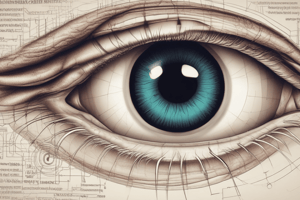Podcast
Questions and Answers
Which layer of the eye does not include the Canal of Schlemm?
Which layer of the eye does not include the Canal of Schlemm?
- The iris
- The cornea
- The choroid (correct)
- The ciliary body
What is the common technique of anesthesia for strabismus surgery?
What is the common technique of anesthesia for strabismus surgery?
- TIVA anesthesia
- Regional anesthesia (correct)
- Local anesthesia
- General anesthesia
What is the function of malate hydrochloride eye drops?
What is the function of malate hydrochloride eye drops?
- To decrease the amount of aqueous humor
- To increase IOP in glaucoma
- To decrease IOP in glaucoma (correct)
- To dilate the pupils
Which of the following is NOT a component of intraocular pressure?
Which of the following is NOT a component of intraocular pressure?
How many rods are there approximately in each eye?
How many rods are there approximately in each eye?
What is the purpose of keratoplasty?
What is the purpose of keratoplasty?
Flashcards
Normal IOP and Aqueous Humor Volume
Normal IOP and Aqueous Humor Volume
The normal range is 10-20 mmHg. Total volume is 0.2-0.5 ml.
Aqueous Humor Drainage
Aqueous Humor Drainage
Secreted by the ciliary body epithelium, it drains through the trabecular network, Canal of Schlemm, and episcleral venous system.
Optic Nerve Function
Optic Nerve Function
Conducts visual information from the eye to the visual center in the brain.
Tear Drainage Pathway
Tear Drainage Pathway
Signup and view all the flashcards
Keratoplasty
Keratoplasty
Signup and view all the flashcards
Atropine's Ocular Effects
Atropine's Ocular Effects
Signup and view all the flashcards
Study Notes
Ophthalmology Exam Review
- The normal intraocular pressure (IOP) is 10-20 mmHg and the total amount of Aqueous humour in the eye is 0.2-0.5 ml.
- The human eye has about 6 million cones for high threshold vision and about 120 million rods for low threshold vision.
- Aqueous humor is secreted by the ciliary body epithelium and drains through the trabecular network, Canal of Schlemm, and episcleral venous system.
- The optic nerve conducts sense of vision from the eye to the visual center.
- Tears drain to the nasal cavity from the nasolacrimal duct through the inferior and superior lacrimal canaliculi.
- The components of Aqueous humor include glucose, water, and oxygen, but not red blood cells.
- The middle layer of the eye consists of the choroid, ciliary body, and iris, but not the channel of Schlemm.
- Atropine causes pupillary dilation and cycloplegia, but does not increase IOP.
- Malate hydrochloride eye drops decrease IOP in glaucoma and are beta 1 receptors.
- Local anesthesia is preferred for pterygium, dacryocystorhinostomy, and strabismus surgery, but not for penetrating eye injury or keratoplasty.
- The common technique of anesthesia for strabismus surgery is regional anesthesia, not TIVA or general anesthesia.
- Keratoplasty is a corneal transplant surgery that can alleviate pain, provide tectonic support, eliminate infection, amplify refractive error, and improve visual acuity.
Ophthalmology Quiz Summary
- The normal intraocular pressure is 10-20 mmHg and the total amount of Aqueous humour in the eye is 0.2-0.5 ml.
- Rods are high threshold receptors for light and there are approximately 120 million in each eye.
- Aqueous humor is secreted from the ciliary body by epithelium and does not contain RBCs.
- The optic nerve conducts the sense of vision from the eye to the visual center.
- Tears drain to the nasal cavity from the nasolacrimal duct via the inferior and superior lacrimal canaliculi.
- Ketamine should be avoided during induction of anesthesia in a patient with acute eye trauma.
- Atropine's ocular effects include mydriasis and cycloplegia but do not increase IOP.
- Malate hydrochloride eye drops decrease IOP in glaucoma.
- The middle layer of the eye consists of the choroid, ciliary body, and iris but not the canal of Schlemm.
- Episcleral venous pressure is not a component of intraocular pressure, which is maintained by the aqueous and vitreous humor.
- Keratoplasty involves replacing the host cornea with a healthy donor cornea to alleviate pain, provide tectonic support, eliminate infection, and improve visual acuity for conditions such as congenital corneal degenerations, corneal scars, and keratoconus.
- Ectropion and entropion are eyelid disorders that cause discomfort, irritation, and lacrimation, but only entropion causes photophobia and epiphora. Cicatricial, congenital, paralytic, and spastic are specific categories of these disorders.
Studying That Suits You
Use AI to generate personalized quizzes and flashcards to suit your learning preferences.




